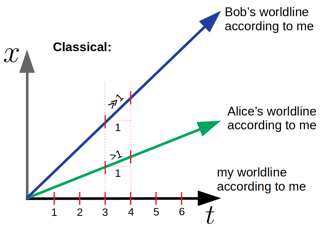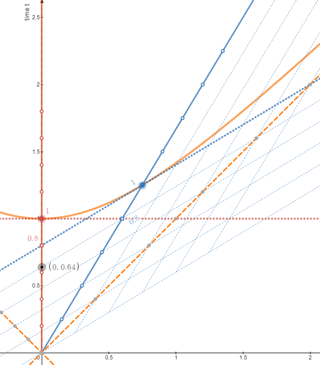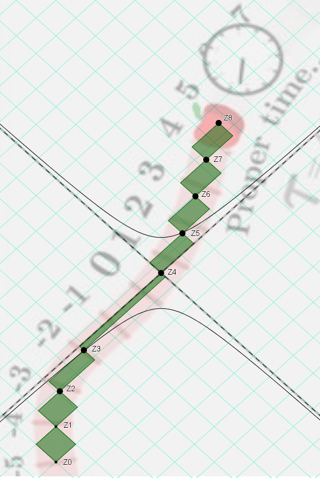In this video series on relativity, proper-time is explained as "evenly spaced gradations" along a particle's worldline. Here is a screenshot:
Suppose I carry a clock with me that ticks at regular intervals. I define the time between each tick to be 1 time-unit. From my perspective, my position is constant, and thus my worldline is entirely along time.
Suppose Alice and Bob are traveling relative to me (and vis versa). They are carrying clocks identically constructed as mine. We all zero our clocks when we coincidentally cross paths. From then, I plot their positions against my clock.
Based on the video, I am inclined to draw evenly spaced ticks on Alice and Bob's worldlines and call that their proper-times.
Does this mean that, say, Bob believes his 4th tick occurs just before my 3rd tick, as shown below? This would be some kind of time-dilation, because I am concluding that Bob thinks my clock is running slow.
However, it seems strange to derive any sort of time-is-relative effect from just placing even tick-marks along worldlines. I'd think we'd need to declare the invariance of $c$ somewhere. Moreover, the above diagram provokes a kind of "circular" transformation rather than the correct hyperbolic (Lorentz) transformation..
On the other hand, just saying "your clock ticks regularly along your worldline" is fundamentally different than the classical perspective, where everyone shares a time axis like this:
Essentially, my question is: if this understanding of proper-time as "even gradations" is correct, how does it relate to actual time-dilation and the Lorentz transform?
For posterity: I'd like to leave what I think is a more clear version of the answer below. Proper-time is indeed evenly spaced on the worldline, but how to choose which of an infinite number of ways to assign such even gradations is where my confusion was. I presented a sort of Pythagorean transform that preserves $dx^2+ dt^2$ as the only option, but it's not. With just the discussion in my question, I could have given Bob twice as many ticks (still evenly spaced) and drawn different conclusions. In SR reality requires a hyperbolic transform preserving $dx^2 - (c dt)^2$. Even the shear transform of Galilean relativity generates even ticks, they just preserve $dt$. The metric dictates what it means to preserve length between ticks / what it means to be on a circle. My time-axis ticks must transform along that "circle" to find their correct evenly spaced homes along the observed world-line.









